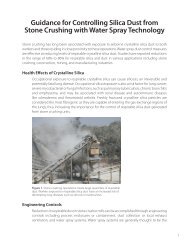Hazards in the Workplace - Occupational Knowledge International
Hazards in the Workplace - Occupational Knowledge International
Hazards in the Workplace - Occupational Knowledge International
You also want an ePaper? Increase the reach of your titles
YUMPU automatically turns print PDFs into web optimized ePapers that Google loves.
HOW TO CONTROL SILICA DUST AT WORK<br />
The only effective protection aga<strong>in</strong>st silicosis is to prevent silica dust <strong>in</strong> <strong>the</strong> air. Under <strong>the</strong>ir<br />
obligations <strong>in</strong> <strong>the</strong> <strong>Occupational</strong> Health and Safety Act, employers must take measures to ensure<br />
that workers are not exposed to silica dust. There a number of simple control measures that<br />
can be taken.<br />
• Use a water hose to wet dust down at <strong>the</strong> po<strong>in</strong>t of dust generation. Water can be used<br />
through non-electric cutt<strong>in</strong>g or gr<strong>in</strong>d<strong>in</strong>g tools to reduce <strong>the</strong> dust <strong>in</strong> <strong>the</strong> air.<br />
• If it has to be a dry process, a dust control system with a suitable capture velocity can be<br />
used to extract silica dust.<br />
• Encourage good work practices to m<strong>in</strong>imise exposures to nearby workers or <strong>the</strong> public, <strong>in</strong><br />
some cases.<br />
Dust levels <strong>in</strong> <strong>the</strong> air should be monitored by a competent person. The exposure limit for silica<br />
dust (respirable quartz) is 0.1 mg/m3. However, exposure levels <strong>in</strong> sett<strong>in</strong>gs like construction<br />
sites are highly variable and air sampl<strong>in</strong>g alone is not enough to <strong>in</strong>dicate <strong>the</strong> health risks from<br />
airborne silica dust.<br />
In some build<strong>in</strong>g work, silica dust problems can be elim<strong>in</strong>ated by us<strong>in</strong>g pre-built materials for<br />
plumb<strong>in</strong>g and wir<strong>in</strong>g.<br />
Respirators should not be <strong>the</strong> primary method of protect<strong>in</strong>g aga<strong>in</strong>st silica dust. A suitable type<br />
of respirator may be used until adequate dust controls are put <strong>in</strong> place. Workers must be<br />
tra<strong>in</strong>ed <strong>in</strong> <strong>the</strong>ir proper use and ma<strong>in</strong>tenance.<br />
ARE MEDICAL TESTS NECESSARY?<br />
The disease is difficult to detect at <strong>the</strong> early stages because of <strong>the</strong> absence of symptoms.<br />
However, chest x-rays can help identify some of <strong>the</strong> cases and hopefully reduce <strong>the</strong> severity of<br />
disease.<br />
As a preventive measure, medical monitor<strong>in</strong>g should be available to those workers <strong>in</strong><br />
occupations where <strong>the</strong>y may be exposed to crystall<strong>in</strong>e silica. These should be done before job<br />
placement and at least every 3 years <strong>the</strong>reafter. High-risk jobs should be given annual medical<br />
exam<strong>in</strong>ations.<br />
This Fact Sheet is courtesy of <strong>the</strong> Workers Health Centre<br />
Silica factsheet - Unionsafe New Southwales.doc Page 2







